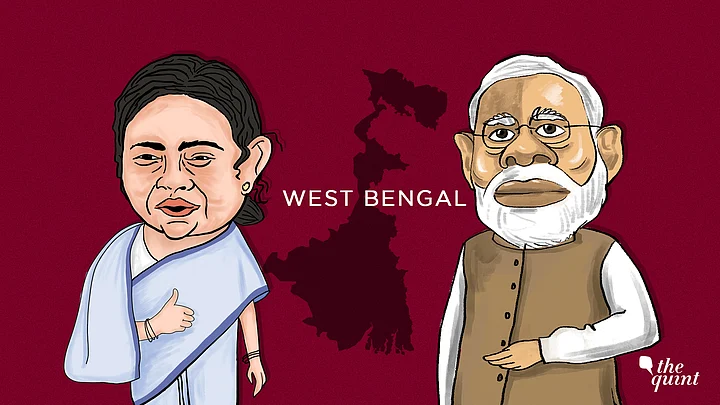Political observers in West Bengal were in for a shock as the results for the 2019 Lok Sabha elections of the state’s 42 seats emerged. As of late 9 pm on 23 May, the seat tally for the Trinamool Congress stood at 22 (down from 34 in 2014), that of the BJP stood at 18 (up from two in 2014) and the Congress won two seats (as opposed to the four it won in 2014).
While an indication of this result came via the India Today-Axis exit poll, observers did not give the saffron party anything more than 10 seats in the state. So where did the Trinamool lose ground and how did the BJP capitalise on these losses? Here’s a look.
BJP Sweeps the Hills
As was expected, the BJP made the most gains in North Bengal where the party also performed well in the 2018 panchayat polls.
Of the four hill constituencies – Alipurduars, Coochbehar, Darjeeling and Jalpaiguri – the BJP won all four.
While the Gorkhaland issue sealed it for the BJP in Darjeeling, in spite of a weak candidate, the tribal push by the BJP also meant that a large chunk of the Adivasi votes in Alipurduars and Coochbehar – both border districts with many tea garden Adivasi workers – went to the BJP.
Moreover, large-scale violence in these areas during the panchayat polls and walkovers in many seats meant that voters were largely restricted from voting in the polls. The discontentment with the Trinamool, thus, manifested in the Lok Sabha polls.
In the seat of Balurghat, factionalism within the Trinamool ranks ensured that the BJP went ahead.
In the Congress bastion of Malda North, Trinamool candidate Mausam Noor’s defection from the Congress was not taken kindly by the people. Here too, a large Adivasi population voted entirely for the BJP’s Khagen Murmu, taking him to victory.
In the crucial Raiganj seat too, vote division between the Congress and the Left ensured a BJP victory.
Jangalmahal ‘Hasche Na’
One of the Trinamool’s most famous advertisements in the poll season said “Pahar hasche, Jangalmahal hasche”, meaning, “the hills are laughing, Jangalmahal is laughing.”
Clearly, that was not the case. As explained earlier, while all the hill constituencies were lost, Trinamool lost all the five Jangalmahal constituencies as well, as the BJP successfully converted even those that seemed like a tough contest. This is especially commendable as the party did not have the organisational machinery available to the Trinamool.
While there was an evident saffron surge in tribal-dominated constituencies of Purulia and Jhargram, of the other three, two – Bankura and Medinipur – looked difficult for the BJP.
In Bankura, the Trinamool was trying to undo damage done by Moon Moon Sen during her tenure as MP from the constituency. The ground level cadre in the constituency seemed less than enthused and the BJP managed to turn this in their favour.
In Medinipur, where the saffron party fielded state president Dilip Ghosh against veteran politician Manas Bhunia, the BJP came out victorious after many rounds of neck-and-neck contest.
The panchayat poll factor worked in Bishnupur too.
Unexpected Losses For The Trinamool in South Bengal
In the south, the BJP won Asansol, Bardhaman-Durgapur, Ranaghat, Hooghly, Barrackpore and Bongaon.
In all of these places, except Bongaon, the BJP’s polarisation tactic seemed to have worked. What made these results surprising is that the silent voter in these areas voted for the BJP.
In Asansol, the BJP’s Babul Supriyo won by a considerable margin in spite of fighting massive anti-incumbency and the Muslim population in the constituency voting largely for the Trinamool. The adjoining seat of Bardhaman-Durgapur, where the BJP had fielded SS Ahluwalia (formerly MP from Darjeeling), the Trinamool (and political observers) were sure of a win. However, massive polarisation worked here too.
What should worry the Trinamool is that most of these areas that it lost in the south is urban centres, which means that the urban, upper class voters – deemed largely ‘liberal’– is voting against the TMC.
Factionalism led to 25-year-old widow Rupali Biswas’ downfall in Ranaghat, whereas Locket Chatterjee’s win in Hooghly can also only be explained by polarisation.
Barrackpore was a tough contest till the last few rounds between Trinamool’s Dinesh Trivedi and ex-TMC MLA and strongman, BJP’s Arjun Singh, until Arjun came out victorious by over 14,000 votes.
The Adivasi and panchayat poll factors worked against the Trinamool in Bongaon as well.
The votes also show that the BJP has won 130 Assembly segments of the 292 in the state. The question now is, if Mamata Banerjee will be able to re-assert her supremacy before the state elections of 2021 in order to prevent the BJP from taking Bengal, once and for all.
